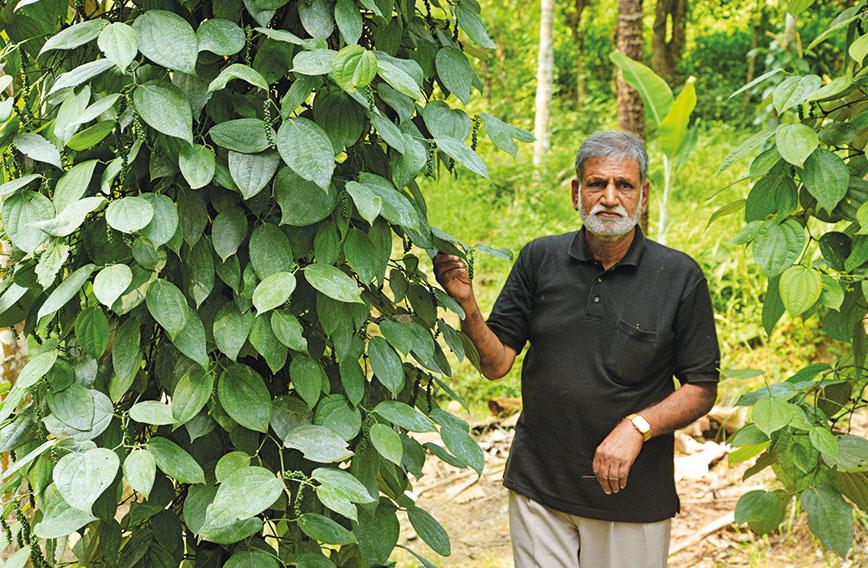
Venugopal in a pepper garden where, with his advice, yields have increased
M.N.R. Venugopal
Dr Madhugiri Narayana Rao Venugopal, a scientist with the Indian Council of Agricultural Research (ICAR), was living a retired life when a farmer urged him to share his immense knowledge with people who needed it.
Dr Venugopal then stepped in to not just help but also play a transformative role by showing how pepper could be profitably grown on coffee and areca nut plantations. He began travelling 12 to 15 days a month across five districts in Karnataka. With his guidance, farmers have been able to increase their yield and income. He has also helped farmers set up gene banks and improve the quality of plants.
In return for all his help, Venugopal expects nothing from the farmers. He is a humble man and says that his pension is enough for his family. But the farmers have always felt indebted. So, when he fell seriously ill in 2015, farmers contributed to pay the hospital bill.
Below is a piece that appeared in Civil Society's September-October 2017 edition. Read on.
In the sleepy villages of Sirsi in Karnataka an economic revolution is taking place. In just four years, farmers have tripled their income by growing pepper, the king of spices. Word of pepper’s potential has spread to five districts of Karnataka — Uttara Kannada, Shimoga, Chikmagalore, Hassan and Kodagu — and here too farmers are making money by growing the black spice.
The man behind this silent transformation is 68-year-old Dr Madhugiri Narayana Rao Venugopal, a retired ICAR scientist, affectionately called ‘Pepper Doctor’. By assiduously sharing his knowledge with farmers he has increased their yield of pepper by three to four times.
     |
Dr Venugopal was born in Madhugiri in Tumkur district, the eighth child of Narayana Rao and his wife, Seethamma. In 1977 he joined the Central Plantation Crops Research Institute at Kasargod. He retired in 2009 after 32 years of service from the Regional Research Station of the Indian Institute of Spices Research, Madikeri, as its Principal Scientist and Head. By then he was an acknowledged expert in crops like arecanut, coconut, pepper, ginger, turmeric and cardamom.
Venugopal built a house in Mysore and was looking forward to a quiet life with his family. A few months into retirement, he was invited to a farmers meet in Madikeri. Ravi Ganapathy, a farmer, struck up a conversation with him. “You are a man of immense knowledge,” he said. “Transfer your learning to those who need it instead of killing it.”
His words got Venugopal thinking. He decided he would spend his time helping the farming community. Venugopal began attending meetings of farmers and he didn’t miss a single opportunity to address them. By now he must have attended around 1,300 such meetings. “All I needed was Rs 250 for travel,” he remarks. Alongside Venugopal began identifying farming clusters that could increase their yield of pepper to more than 1,000 tonnes annually.
Why did he choose pepper? “There is money in pepper,” he says. “Coffee growers contend with white stem borer. Arecanut farmers worry about over-production and tea planters have high overheads. Pepper production is stagnant but farmers are keen to increase their income. What they lacked is guidance and adequate planting material,” he explains.
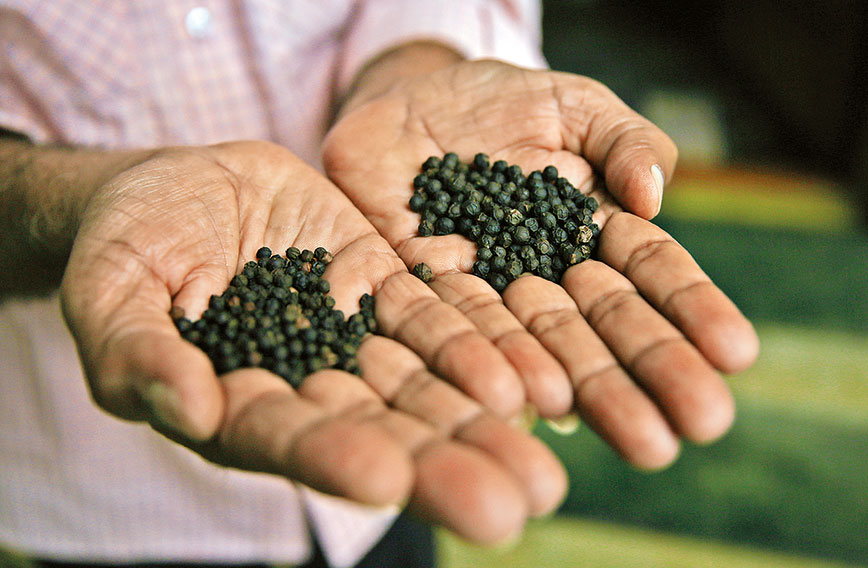 A handful of pepper
A handful of pepper
“Dr Venugopal has been coming often to our taluka since 2012. At that time, our pepper production was around 75 to 80 tonnes. Now it has reached 300 to 320 tonnes. Within the next two to three years, we will be producing 800 to 900 tonnes,” says Mahabaleshwar B.S., Assistant Director of Horticulture, Siddapura, in Uttara Kannada district.
In the 10 years since he retired, Dr Venugopal has probably achieved more than in the 30 years he worked for the government. Not only has he tripled the income of farmers he has forged deep bonds with them, giving rise to a new model of farmer-scientist relations.
“Scientists use power point presentations to train farmers. But cut and paste guidance isn’t enough. What works for pepper plants in an arecanut garden won’t suit pepper growing on a coffee farm. Scientists should demonstrate their learning on farmers’ fields. Otherwise no cultivation package will succeed,” he says.
In India pepper is cultivated as a mixed crop with arecanut, coffee and tea, unlike in Vietnam, the world leader in pepper production, where it is a mono-crop. “Pepper doesn’t require much space or irrigation. With the right agronomic practices we can augment production phenomenally,” says Venugopal. In another two years Karnataka will produce 65,000 tonnes of pepper or all the pepper India consumes, he says.
BONDING IN CLUSTERS
Dr Venugopal travels at least 12 to 15 days in a month. The farms are not very near. A visit to Sirsi, which is nearly 1,000 km away, requires an overnight journey. He travels by bus and train. In fact, he admonishes farmers if they offer him special attention and happily stays in their homes. What’s more, he doesn’t accept a single rupee for his services.
“My pension is enough for my family”, he says. “I don’t take any money from small farmers. I receive a consultation fee from big farmers that I use for small farmers. They arrange food, bus charges and accommodation, if required.”
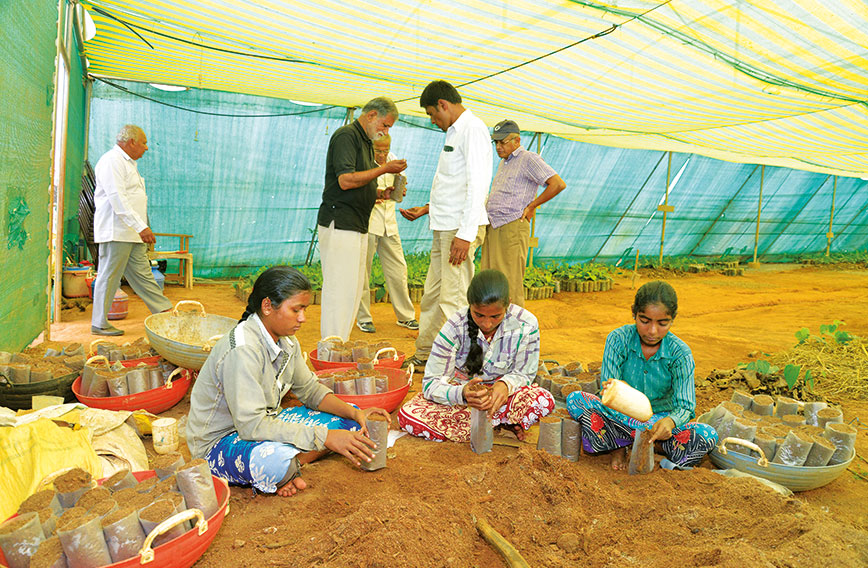 Farmers have been encouraged to set up gene banks and nurseries
Farmers have been encouraged to set up gene banks and nurseries
The first time Venugopal visits a new garden, he enquires how many pepper vines it has. If the number is less, he suggests the farmer plant more. “I tell them this is your yield potential. I ask them if they are ready to achieve a production of 300 to 400 kg per acre with 100 vines. It is not difficult. If the farmer agrees, I advise him from time to time. I also put forth one condition — farmers should implement 80 per cent of my recommendations and inform me. Otherwise, I don’t go there again.” Of course, there are defaulters — as many as six out of 10!
He also has a clear strategy. First, Venugopal identifies clusters that can grow 1,000 tonnes of pepper. Next he finds key farmers — those who are opinion leaders and can share knowledge. He has so far identified 14 clusters in five districts stretching from coastal zones up to an altitude of 1,200 metres with rainfall from 30 to 300 inches.
“After assessing rainfall, soil and so on we can evaluate in general the problems being faced by farmers. But we can’t provide the same advice to the entire state,” he says. In each cluster, Venugopal develops a demonstration plot in the garden of a key farmer. In Uttara Kannada district he has developed three demonstration plots — in Gadikai, Neernalli and Chavatti.
In a way, the clusters act as relay centres of his recommendations. Whenever there is the possibility of a pest attack or quick wilt disease, he alerts the clusters over phone which, in turn, alert their communities. Pepper farmers have formed groups on WhatsApp and they also have organisations. So a lively exchange of information takes place. In the Siddapur taluka alone there are eight such groups. The Sirsi taluka has 10 groups. “In the past, no farmer discussed his pepper farming experiences. Now no development remains uncirculated,” remarks Mahabaleshwar.
Venugopal communicates very carefully. So he doesn’t offer advice over phone when he is travelling. At home, he receives 15 to 30 calls every day from pepper farmers. If it’s a very special case, like a call from a farmer in the northeast wanting to replace rubber with pepper, he suggests a team visit suitable plots and he facilitates training. In a year six to eight such study teams arrive to undergo training.
“Our garden becomes his. He keeps tabs on our agricultural practices and guides us. He takes up all our farming worries. But the income accrues to us,” says Chavatti Shridhara Bhat, a farmer in Sirsi. “When he visits our farms, he is always the leader and we are happy to follow. He even interacts with our workers. Whenever he finds an improved pepper variety, he takes pains to distribute it to all farmers. Varieties from the northeast have been brought here. Our varieties have gone there. Venugopal is like a friend or relative for us.”
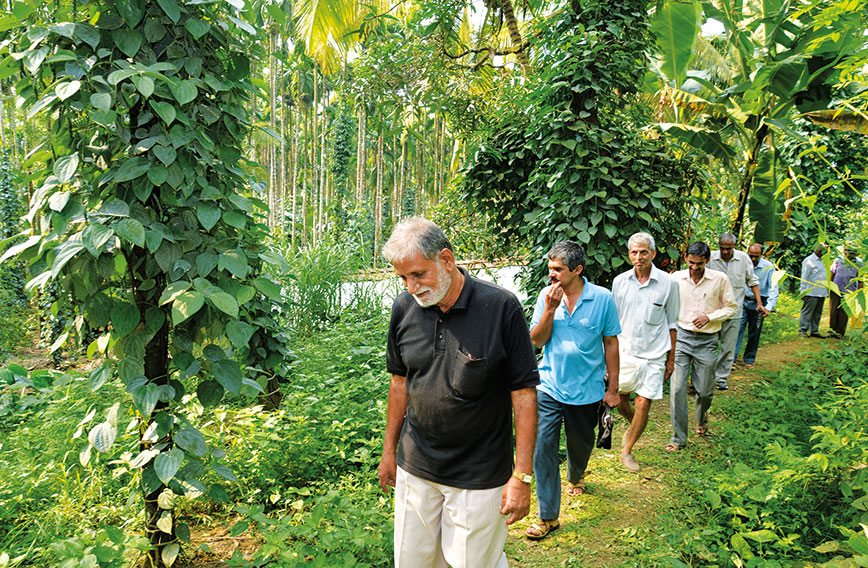 Walking past pepper vines followed by farmers
Walking past pepper vines followed by farmers
THE RIGHT RESEARCH
The most popular variety of pepper here is Panniyur-1. Pepper growing regions have millions of this variety. But it has a peculiar problem. During its spike formation stage, if there isn’t enough light, the plant produces only female flowers instead of bisexual ones. Laughs Venugopal, “Panniyur-1 is naughty but also a champion. We have had to change production technology because Panniyur-1 is planted very extensively.”
With early irrigation and by preponing flowering, farmers can ensure there is adequate light for a good crop. This is recent acquired research which is being widely disseminated.
A farmer in Somavarpet had been harvesting 28 tonnes of pepper from 38 acres. One year his pepper vines were attacked by quick wilt disease and he got no yield. He discovered that the disease had originated in his neighbour’s garden. Scientists advised him to start control measures from the neighbouring garden. That worked and even after 26 years his vines are healthy. But his neighbour’s vines turned sick and had to be replanted. “The acid test of any experiment is in farmers’ fields,” says Venugopal.
One reason most arecanut farmers were wary about growing pepper is its frequent mass mortality. If there is uninterrupted rain for a few weeks, the dreaded quick wilt disease invariably wipes out vines. Farmers were under the impression that vines have to be constantly replanted to be free of quick wilt. But this fear has considerably declined due to Venugopal’s advice.
THE GENE BANKS
An important prerequisite for pepper development is quality planting material. Throughout his career Venugopal noted that most saplings didn’t measure up. Some had symptoms of nematode, others were infected with phytophthera fungus or virus. Very few nurseries raised healthy planting material.
To overcome this problem, Venugopal insists that every cluster create its own gene bank. Three gene banks have already started in the districts of Sirsi, Shimoga and Hassan. Research and nurseries should go hand in hand is Venugopal’s motto. He has also trained farmers and nurseries to produce pepper plants locally. Today there are 58 farmer-owned nurseries.
The problem with planting material is that only one variety and production technology is promoted whereas the Western Ghat region contains great varietal diversity. Karnataka has 14 documented varieties. Kerala has over 70. “In some areas, we don’t want champions. We need all-rounders — cultivars less susceptible to disease, less sensitive, even if the yield is moderate,” he says.
With this objective Venugopal arranged a nine-day varietal selection process in pepper gardens three years ago. “We selected 17 varieties in Uttara Kannada. In an area where all pepper vines had died, we found a variety called Tirupugere. Both Okkalu and Kari Malligesara varieties fetch Rs 80 more per kg in the local market. Nine out of 17 local cultivars are quite promising and deserve to get geographical identification,” he says.
Take the case of Okkalu. Chavatti Shridhara Bhat was growing this variety on his farm. But it was yielding only 500 gm of crop per vine. Bhat was very disappointed and was all set to cut off his Okkalu vines. Venugopal advised him to give his vines the correct dose of nutrients. Now the same variety produces four kg per vine and traders are paying Bhat `80 more for his pepper crop.
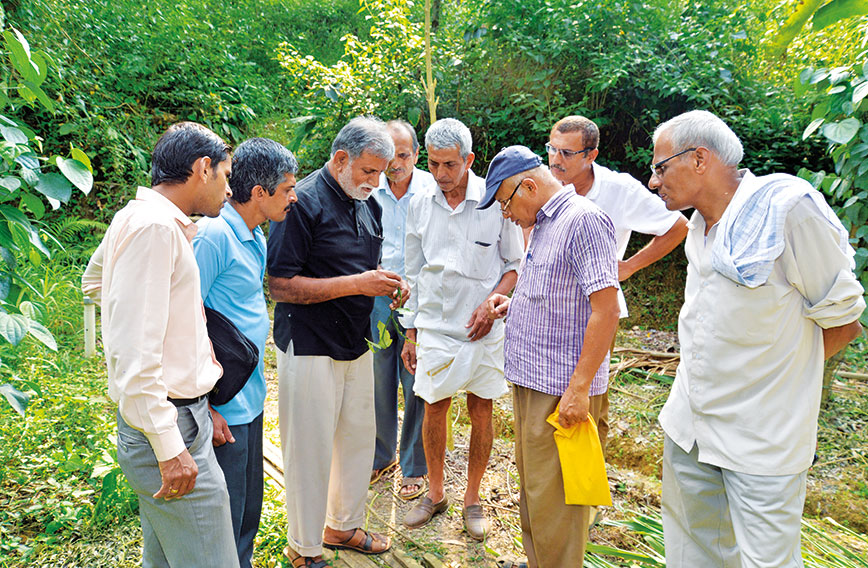 Venugopal with a group of pepper farmers with whom he has formed strong bonds of trust
Venugopal with a group of pepper farmers with whom he has formed strong bonds of trust
LEADERS OF FARMERS
Two years ago Venugopal fell seriously ill. After returning from Assam in June 2015, he got paralysed. The disease, called GB Syndrome, affects one in 100,000 people and results from excessive antibody production for a virus. His vision was affected and he couldn’t even lift his hand. For 23 days he was virtually helpless.
Even at this critical juncture, he was more concerned about the thousands of farmers for whom he was a leader. He phoned some of them to whisper a two-line message, “I don’t know if I can visit you again. Please stick to my recommendations.” Groups of farmers started rushing to the hospital. Everyone began praying for him. Eventually, “there was a miracle, a rebirth,” says Venugopal. He began recovering and after two and a half months he was back on his feet, travelling to the fields of farmers.
The hospital bill came to nearly Rs 10 lakhs. Farmers contributed to ease the financial burden. “You are our asset. You have to live for us. We have benefitted so much thanks to you. If every farmer contributes just five kg of pepper we can easily clear this bill,” they kept saying. The Indian Institute of Spices Research reimbursed some money.
Venugopal works quietly, away from the limelight. Yet he has become a legend in these five districts. No ICAR scientist has his dedication and hard work or guides farmers with so much sincerity. There are no parallels to our pepper doctor, say farmers.
Shree Padre travelled to Mysore and Sirsi to speak with farmers and spend time with
Dr Venugopal. Yajna took the pictures.
Comments
-

K P MALLESH - Feb. 15, 2023, 2:16 a.m.
Excellent simple mind-blowing perfect scientifically approach



